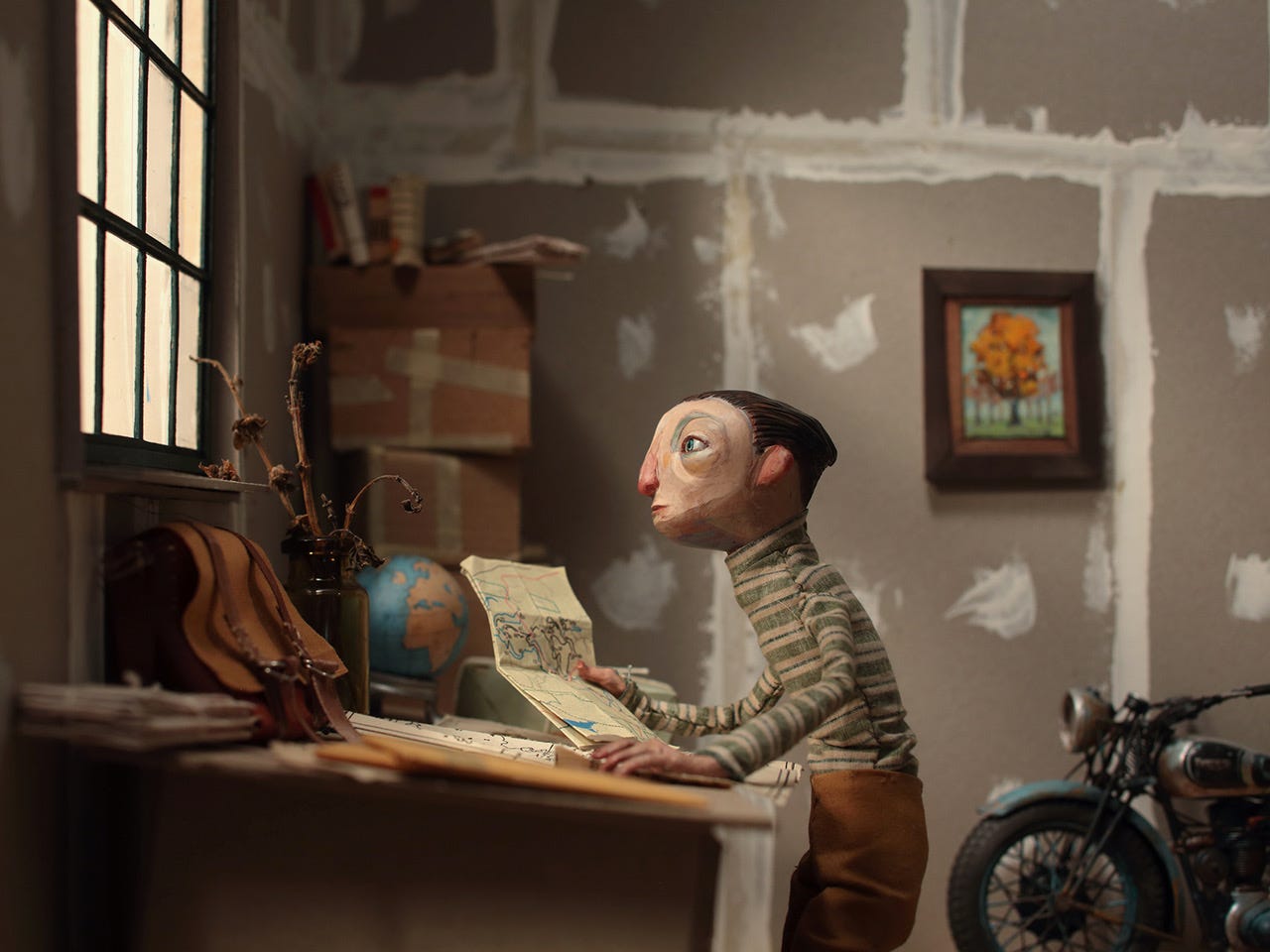
Art, craft and storytelling runs in my family. Despite the proliferation of modern content and media filling our small and large screens as a society, sometimes something new comes along that harkens back to the old, prompting a warm feeling cascading up from the belly to form a smile on my face.
I became aware of Indiana native Chris Sickels of Red Nose Studio and his throw-back 3D illustration and stop-motion animation craft 11 or so years ago after watching this video, and have followed his journey on Instagram and in print and digital interviews.
After a bit of back-and-forth correspondence between my northern California office and his central Indiana home workshop, we tightened the 2,311-mile distance with the following interview.
Chris, you live in the small town made famous by the ‘Hoosier Poet’ James Whitcomb Riley. Does the Golden Age of Indiana Literature inspire you in your Greenfield workshop?
For the longest time I felt like that part of Greenfield was a heavy shadow that kinda implied that 'it' was all about the past. But after being here for a couple decades I have realized that such a vibrant past doesn't mean we can’t continue to thrive. That we have permission to stand on the shoulders of those from the past if we choose, but that our stories, however they are told, have value.
So yes, it does inspire me, just like the Wright Brothers (Wilbur’s birthplace is a stone's throw from Greenfield) didn't wait for someone to give them permission to go after their goals. They went after it full on, trusting themselves with what seems to be a bit of reckless abandon.
Growing up on a farm – my father has told me – requires self reliance, discipline and grit. How do you apply this to your craft? Before you elaborate, explain how you became an illustrator and stop-motion artist.
The earliest drawing my mother kept of mine is of a buffalo in colored pencil when I was six. That simple encouragement by my mother is a key part to why I am doing what I am doing. Mrs. Martin, my high school art teacher, was the first person to tell me that my drawings could take me places. In college, my instructors taught me that illustration could have an emotional core that when infused with your personal stories can have a reach beyond simply just illustrating a narrative.
After college, my passion for all of the aspects and media of art making led me to building physical characters. This is where stop-motion came in, these characters just begged to move. Being a self taught stop-motion animator wasn’t much of a career choice back in the mid 90’s.
So, I took what I loved about stop-motion and fabrication and my passion for illustration and folded them into what I felt I could create on my own without a huge studio of resources.
Perhaps that answers the first part of the question. Using resources that you have, pushing your craft forward even after college, and the sheer determination to stick with it.

When and how did motorcycles become interesting to you? Tell me about your first bike, and all the lovely machines in between then and now.
There came a point when my wife told me that work was overtaking my life, that when I was home, I wasn't fun to be around. She told me I needed a hobby, that art couldn't be both my hobby and my work.
In high school I was part of Future Farmers of America (FFA), and we had a tractor troubleshooting contest where teams of 3-4 kids would be handed a tractor that was deliberately fouled up and we would have a limited amount of time to get it back to running. So, I thought about old tractors as a hobby, but with very limited workshop space, and the fact that pushing a broken down tractor wasn’t something you could do without another tractor, I thought maybe an old motorcycle would fit the bill.
“Mechanical problem solving with simple machines like old bikes, requires a series of things that have to be inline and in sync for everything to work. Basically, spark, air and fuel. And they have service manuals! Art and life do not have a service manual… so that gives me a bit of solace.”
In 2006 or so, I purchased a non-running but mostly complete 1965 Harley-Davidson 175cc 2-stroke called a Pacer. Around 2012, looking to find something a little safer for the road, I acquired a 1966 BMW R 60/2, although by today’s safety standards, drum brakes aren’t exactly considered safe.
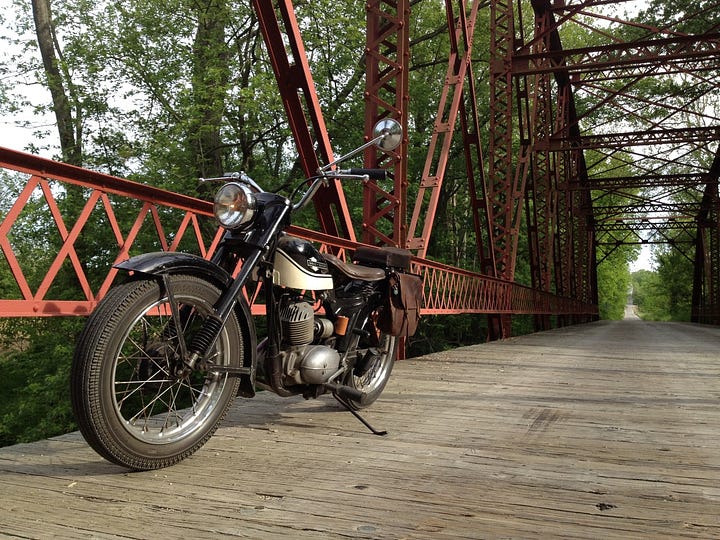
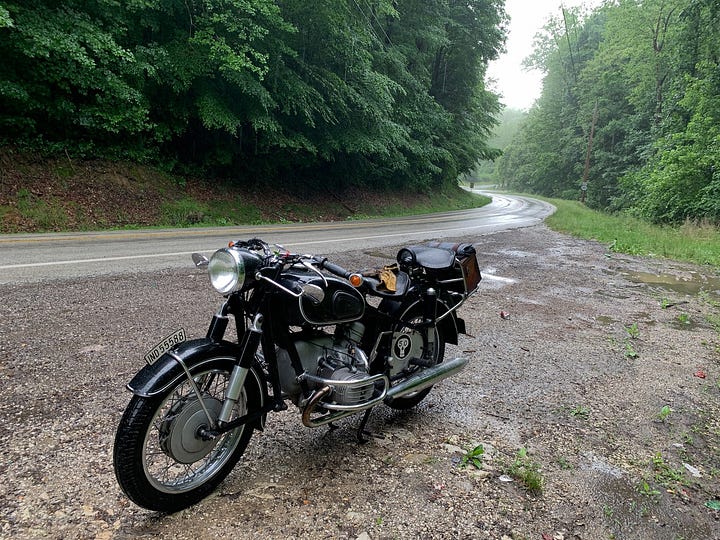
The thing I love about old bikes is that you have to work on them, you can’t just take them to a shop. The problem solving that this requires is a great contrast to my work. Mechanical problem solving with simple machines like old bikes, requires a series of things that have to be inline and in sync for everything to work. Basically, spark, air and fuel. And they have service manuals! Art and life do not have a service manual… so that gives me a bit of solace.
Midwest winters don’t seem to keep you away from your bikes. Where do you like to ride when it’s warmer?
If it’s over 40 degrees, I'm out there when I can be. If we have a few inches of snow, I'll pull the kids around on a sled behind the Pacer. When it’s warmer, I search out the tree covered back roads, heading southeast a bit gets me to a landscape that is less flat with roads that tend to follow creeks instead of grids. Kentucky and Tennessee are our choice getaways; their landscapes and roads are nothing short of heavenly.
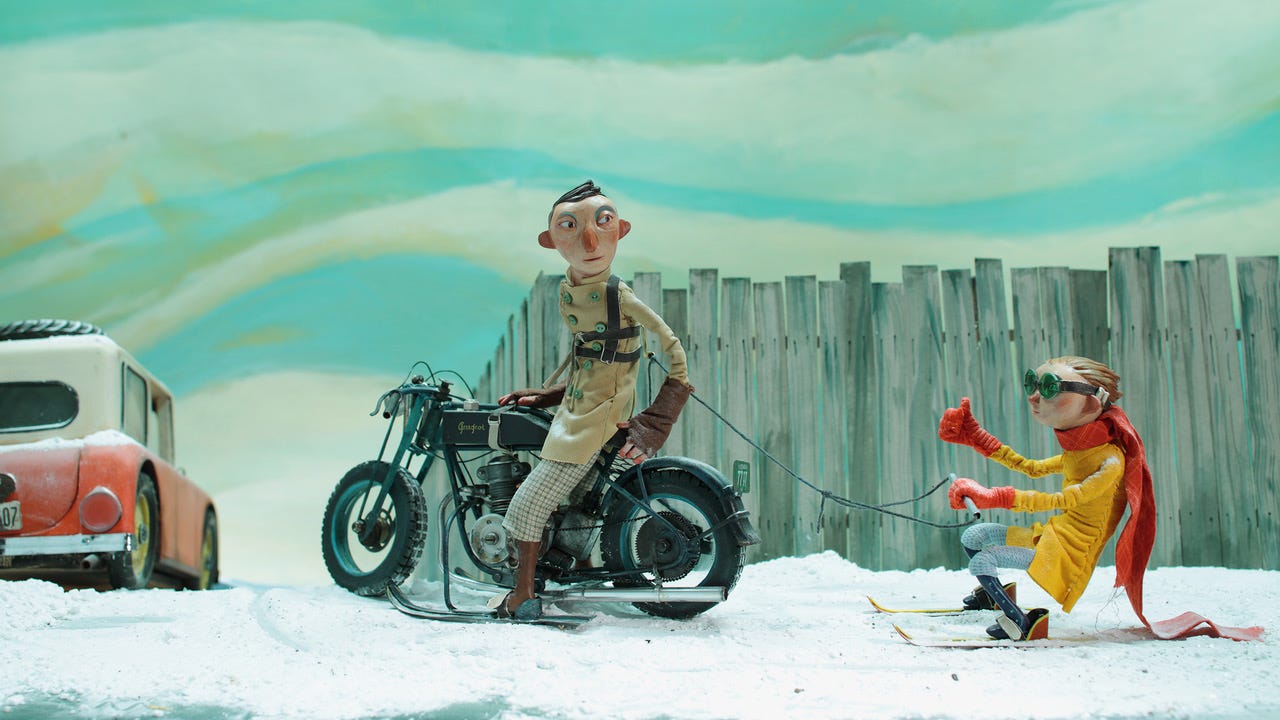
You obviously enjoy working in minutiae – literally. Have you always been a keen observer of tiny details?
Tiny details are a big part of what I do, but those details can often be impressionistic, which means they probably look more detailed than they actually are. That impressionistic quality is what keeps it exciting to me. Physical tools are a huge part of my day, from tiny paint brushes that get very abused, chisels that probably could be a little sharper, sanders with paper that probably could be changed, a miter saw that has a bearing going out of it. All of this probably makes me sound like a hack, but I do change X-Acto blades several times a day.
But in the end, it’s the mind, right? I try to keep an open mind, that if something isn’t going as I planned, I can either fight it tooth and nail or I can step back, re-evaluate and hopefully find a solution that is better in the end. That’s the struggle that tends to keep my best tool sharp.
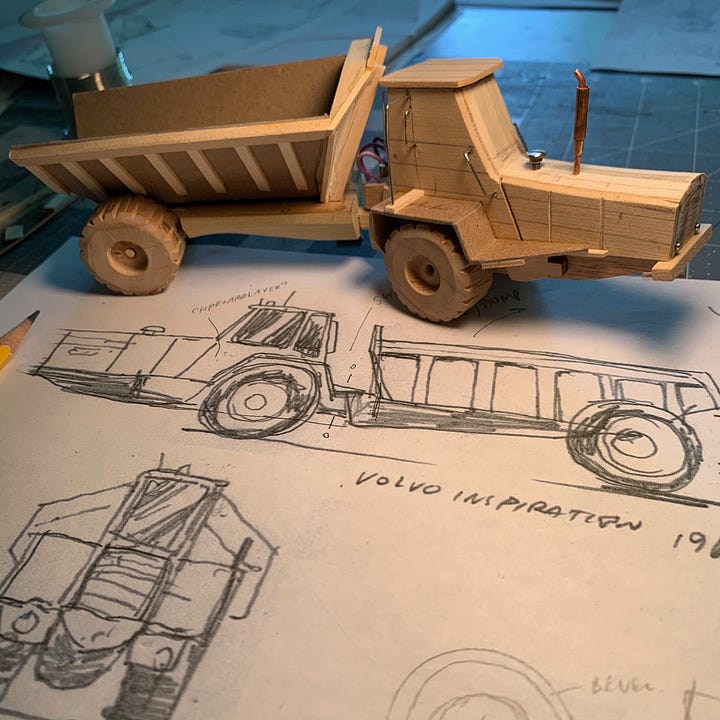
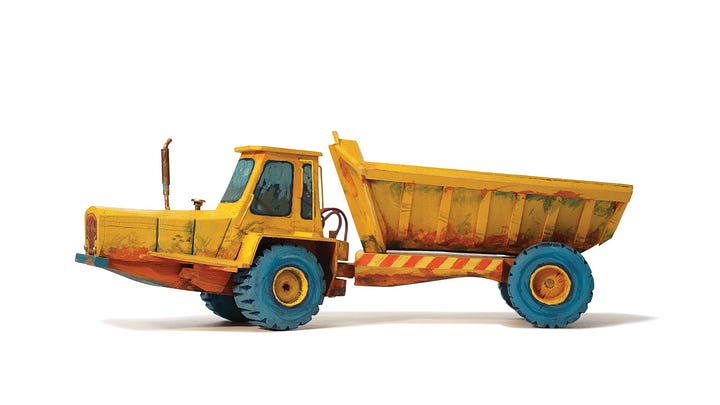
I was born in Green Bay, Wisconsin in 1966, so I’m old enough to have enjoyed all the Rankin & Bass stop-motion television shows. Red Nose Studio is obviously your homage to their work.
By all means, yes, their animations are part of my childhood fabric. I don’t think it was until I was reintroduced to stop-motion through animation festivals (prior to YouTube) where you could see the early work of Aardman, Quay Brothers, Lauenstein Brothers, and Jan Švankmajer among others. Then The Nightmare Before Christmas came out, but being in art school in the 90’s you were encouraged to look beyond the mainstream.
So I started digging into the very early stop-motion of Ladyslaw Starewicz, then George Pal, then Jirí Trnka, then Ray HarryHausen, and then everyone else I don't even know about yet… There is a lovely quality to the early stop-motion that is honest and raw. That is what I try to tap into with my work, rather than trying to make things perfect. Those qualities permeate the Rankin & Bass films, which to me makes them timeless.
A couple of faves in our household include Triplets of Belleville (2003) and everything produced by Aardman Animation. Wallace & Gromit totally rock, yeah?
Amen!
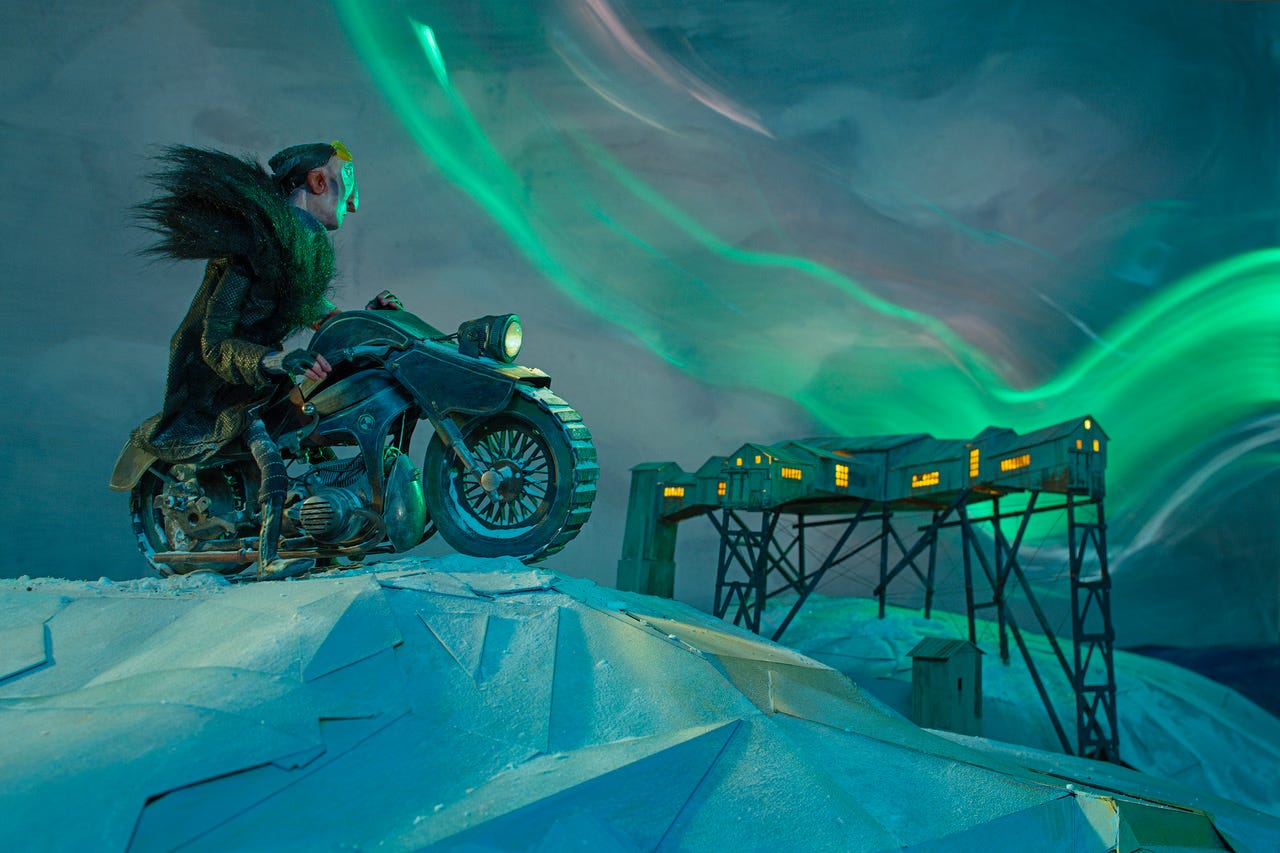
You seem to have a steady flow of design work. How do you balance all the requests while leading a family life to boot?
Family is top priority here, especially with a couple of the kids still being young. Balance is hard, with the labor intensive qualities of my work. Honestly though, work has been a little thinner these last few years, so I am doing my best to enjoy this stage of my life and those who are in it with me.
Among your peers, whose work do you admire and why?
Lydia Ricci for her ability to create a sculpture that transcends the object it mirrors. Her skill and seemingly boundless freedom is an inspiration.
Ainslie Henderson for his ability to breathe life into characters and objects that stretches beyond nearly imitating life.
John Hendrix for his ability to simultaneously construct a written and drawn narrative that distills and organizes complex ideas and thoughts into a delightful experience.
Christoph Niemann who kicks my ass with everything he creates, just knowing how far he has set the bar, shows me that I have lots to learn yet.
Melinda Beck who has excelled at every aspect of what an illustrator’s career could only hope to touch upon. Hers is a benchmark that I can only reach with binoculars.
Which bike would you like to own, wrench and ride, if money were no object and there was space in the garage?
This is a dangerous question for someone who has always been on a limited budget… The 1966 BMW R 60/2 is a pure joy to ride and wrench on, so I am pretty happy with where that is. If you were gonna twist my arm, I’d probably say something about a 1930’s BSA.
You mentioned your appreciation for Matthew B. Crawford’s book Shop Class As Soulcraft. How did you hear about it, when did you read it, and what principles of Matt’s do you jibe with the most?
I think it was NPR, maybe a Terry Gross interview when the book first came out. In my small high school, shop class was where I learned principles of drafting, respecting tools, and learning to listen to the sound of machines to know if all was well or if something was about to break.
Celebrating Matthew B. Crawford
Call it a skill or just a curious habit, but I dig remembering birthdays. Always have; in fact, I care more about the single most important date of a person’s life than what they do for a living. I consider it a survival mechanism living in the heart of Silicon Valley, where even the most wealthy can get bored of accumulating enough folding money to buy shitty homes for millions, then spend millions to make them modern and ugly. I ride by such visual atrocities daily, happy that I’m not living in a futile hamster's wheel of vanity.
I remember my geometry teacher bringing in a large hand drawn schematic of a machine that wrapped candy bars. He had drawn it in his previous career, seeing that first hand had a mesmerizing effect on me…
Back to the book; it reinforced all of those teachings and influences. Now with my oldest kid out of high school and another on her way out, colleges and how they work are at the forefront of conversations at our table. Our oldest chose the trade school route and I couldn’t be prouder of him. The thing is, scholarships and community support for choices like his are slim, so I think it’s gonna take some time for communities to get behind kids with a mindset like his.
We’ll close out our interview with book talk. What were some of your favorites from the last 10 years, and what’s on your nightstand now?
Right now I am reading a graphic novel of Richard Adams’ Watership Down, adapted by James Sturm and artist Joe Sutphin. Prior to that I enjoyed All the Light We Cannot See by Anthony Doerr.
All Quiet on the Western Front by Erich Maria Remarque absolutely broke my heart. I have taken a stab at a couple of Vonnegut novels, but nothing has really hit home for me yet, But being a Hoosier, I am determined to find and like a story of his.
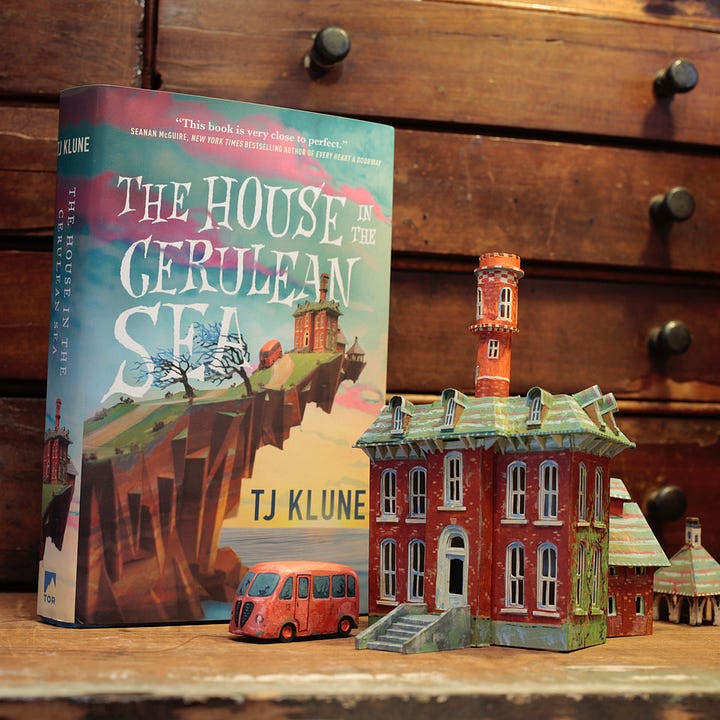
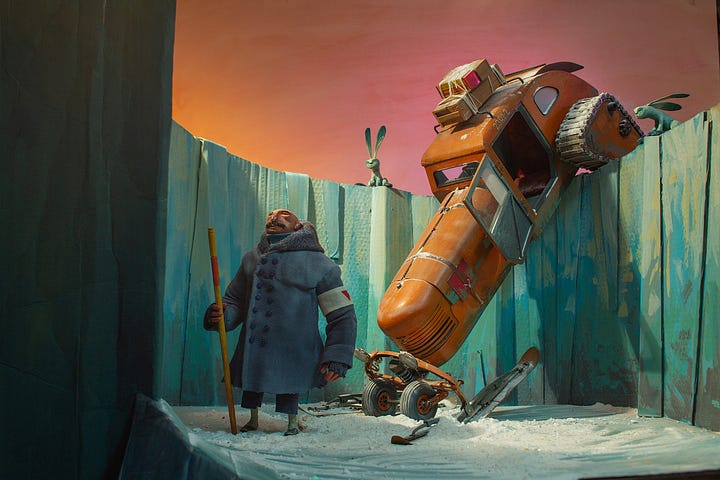
The House on the Cerulean Sea by TJ Klune was a shining light during some dismal days, and I was honored to be asked to illustrate the cover. I have read many books on polar exploration, including The Last Viking by Stephen R. Brown, Alone on the Ice by David Roberts, and In the Land of White Death by Valerian Albanov, all of which inspire me beyond my imagination.





Wow! Thank you for introducing us to Chris Sickels, a clearly talented dude near my neck of the woods. Inspired by his art and his story.
What a lovely person. Every time you introduce me to people through these articles, I wish we could all live on the same block.
Dig his motos.